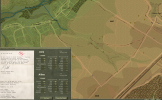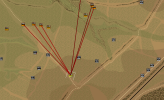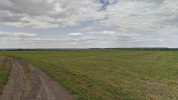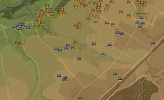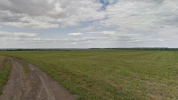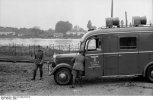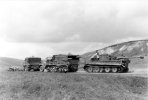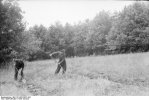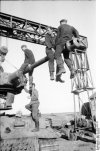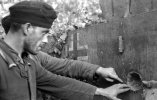It's roughly historical. 2 to 1 losses in armour with the fighting taking place mostly where it did take place historically! The Axis figure includes, of course, many personnel carriers. I counted around thirty tanks lost. All those soviet AFV losses are tanks, however.
Erm, ...... no.
Between 110-140 German AFVs became inoperable (disabled or damaged) between the 12th and the 13th of July.
The 1st SS-Panzergrenadier-Division lost 3 tanks (2 Pz.IV, 1 Tiger), Karl-Heinz Frieser claimed 5 tanks in 1993, in his Book "
Die Ostfront 1943/44 – Der Krieg im Osten und an den Nebenfronten" ("The Eastern Front 1943/44 - The War in the East and (at) the secondary fronts." - My rough translation).
One of the Pz.IVs next to Ribbentrop's tank (he commanded the Pz. Coy comprising of 7 Pz.IV tanks, which acted as initial showstopper for the Russian surprise mass attack) was hit and had caught fire, the other Pz.IV might have been abandoned and demolished by its crew.
But the vast majority of the tanks that had become inoperable or immobile could be retrieved and repaired within hours or days, so that on 16th of July the II. SS-Panzer-Korps had almost the same amount of tanks as right before the offensive:
20 German halftracks were destroyed during the Russian mass tank attack down the hill 252.2, where some were destroyed during their attempts to ram the T-34s to keep them from overrunning Ribbentrop's Coy.
EDIT: Halftracks had to be listed in German strength reports, but different anglo-american authors seem to deliver different total numbers when it comes to AFVs, as say a halfrack with a 75 mm-AT gun, a mortar, AA guns or even MGs is considered to be an AFV by most authors, but considered to be an armoured personnel carrier (APC) or support vehicle by other authors, so that authors who want to present more precise numbers for armored formations rather add up "tanks and [self propelled] assault guns" than referring to (a total number of) AFVs. That said, the Germans lost quite a number of those halftracks after the battle of Prokhorovka, during the retreat later on, if I am not mistaken.
It would be desirable to summarize tank + SPG losses and separate them from the APC and AFV (halftracks) losses in the game's statistics, btw.
On the 12th of July, right before the battle,
- the "Leibstandarte" (1st SS-Panzergrenadier Division) had 77 tanks (including assault guns [AG]),
- the 2nd SS-Panzergrenadier-Division "Das Reich" 95 tanks (incl. AG),
- the 3rd SS-Panzergrenadier-Division "Totenkopf" had 122 tanks (incl. AG),
- amounting to a total of 294 operational tanks.
Between the 13th and the 16th of July
- the Leibstandarte had reported 3 total tank losses (74 tanks remaining),
- the 2nd SS reported 103 operational tanks (incl. AG),
- the 3rd SS reported 121 operational tanks lost (incl. AG),
- amounting to a total of 298 operational tanks (incl. AG).
The higher number of tanks (after the battle) indicates that the Germans were able to retrieve and repair most of the tanks within days, and other tanks that were inoperable (and not used in the battle, as they were under repair before and during the battle) were returned to the field units on July 13, obviously.
On the 11th of July, according to German Strength Reports, German units in the area employed 8 captured T-34s, on the 13th of July 11 (!) and on the 15th of July 13 operational T-34s, so it's obvious that they had been retrieved, repaired and incorporated into their ranks, which would also explain the higher number on July 13, actually. Ten Tiger tanks became inoperable during the battle, but all of them could be repaired. Only 15 Tigers were present in the area.
In Demolishing the Myth: The Tank Battle at Prokhorovka, Kursk, July 1943: An Operational Narrative (2011), Valeriy Zamulin describes that the Russian 5th Tank Army had produced a paper on the 17th of July, which listed
- 222 T-34, 89 T-70,
- 12 Churchill tanks,
- 8 Su-122 and
- 3 Su-76s,
- as well as 240 support vehicles as total write-offs,
as, according to the document, these were declared to be irrecoverable losses (337 tanks and assault guns, excluding "support vehicles" - whatever that description refers to).
The same document also listed damaged vehicles, which were "still under repair":
- 143 T-34,
- 56 T-70,
- 7 Churchill tanks,
- 3 SU-122,
- 3 SU-76
where a number of these vehicles could have been damaged shortly before the battle of Prokhorovka, but where a fair number must have been damaged during the clash at Prokhorovka.
Zamulin also suggests that the German were not caught off-guard and that, due to superior intelligence, the Russian movements were known/discovered and the direction of the imminent Russian push guessed (correctly) by the Germans, beforehand.
EDIT: This adds a twist here, of course, as it allows for delivering a fair explanation (if not excuse) for the high amount of Russian tank losses during the 5th Tank Army's attack. Other Russian sources stress that the battle was much less a mobile battle between tank formations, but an encounter of a "myriad" of prepared German AT ambush positions (which they had occupied/set up when forward observers had reported mass movement on Totenkopf's left flank, means probably less than 1 or 2 hrs before the Russians actually attacked, indeed, but not "myriads"), supported by tanks and (especially) German tactical bombers. All these infos have to be taken with a grain of salt, as quite some of the German documents covering the German losses - which could either contradict or backup Russian claims that the Germans had suffered high troop and tank losses in the Prokhorovka sector - are still residing in the Kremlin's own archive, with quite a number of them still being rated as top secret. Glantz and some German authors were granted access to some of the documents, but the German strength reports found in German and NARA archives contradict such claims (of high German tank losses at Prokhorovka), as all of the 110-140 damaged/immobilized/knocked out German tanks could be retrieved and repaired, except for 3 that had to be written off.
So in fact, he demolishes a smaller part of the myth (where -prior to the 1990s - some Western authors put the Russian total losses as high as 500-700 tanks), but seems to put a "cloak of silence" over the German strength reports covering their extremely low total tank losses (means write-offs) at Prokhorovka.
Zamulin also seems to come to the conclusion that German losses (including tank losses) during the entire southern push of the 2nd Panzerkorps were high, as he includes events prior to the 12th of July, but I am sure that his thinking doesn't include the fact, that the Germans, besides suffering of fair troop losses during the entire southern pincer operation, were able to retrieve and repair almost all inoperable tanks that were damaged during the Battle of Prokhorovka. The rather low amount of losses (some 842 troop casualties on 12th of July and follow. - SS-Panzer-Korps) in the Prokhorovka area actually allowed the Germans to go on the offensive again, after the 12th of July.
Kolomiets and Spirin (1998) suggest 680-720 operable Russian armoured vehicles on the 10th of July, and 408-432 operable Russian armoured vehicles on the 15th of July, which would suggest that a realistic number of losses would range from 272-312 (complete write-offs), where the latter number would be near the range of Zamulin's number (337 AFVs).
Before the Russians attacked, German Panzergrenadier units had occupied tank ditches (which had been prepared by the Russians to slow down or stop German tanks) and did then use them as trenches. When the Russians rushed down and towards the German positions, besides German heavy tanks engaging from afar and the few German medium tanks commencing medium and close combat initially, a good number of AT guns, AT weapons and rifles from those positions then fired at the incoming Russian tanks. Where some Russian tanks had reached the tank ditches, German Grenadiers engaged in a bloody right-in-the-face combat using their magnetic hollow-charges to knock out these Russian tanks, shortly after the aforementioned halftracks had commenced their suicidal attempts to ram the tanks.
While the Russians were ordered to fire on the move (with Russian paras mounted on these tanks) during this attack from hill 252.2, the German Luftwaffe also provided close air support (Luftflotte 4's Hs.129s and Stukas), as their fighters kept up air superiority in that sector, attributing to a good amount of tank kills (in this sector, but also in other sectors), and German artillery slowed down Russian tank and inf movement, and even immobilized or knocked out a number of tanks, while the Russians artillery in support of the attack had run out of ammo quickly, due to a major supply failure (for several reasons, according to Zamulin). While the Germans could freely cross the tank ditches via little bridges and crossings built by German engineers, and go back and forth, Russian infiltration was denied by the Germans, for a while, because SS Grenadiers had dug in on hill 252.2, which contained bunkers and trenches, as it was the center of the German line.
The Germans then used the Russian trenches, which offered reversed/reduced protection only (as they were designed to offer protection from German fire from the other side), whereas the surrounding terrain (flat, slightly sloped terrain, with grass that just offered concealment to say a platoon, but not Bns or divisions) featured no protection for infantry at all.
EDIT: Eventually, at the Leibstandarte's position, (according to German veteran accounts collected by FRIESER) the Leibstandarte's tanks lined up behind one of the largest tank ditches, which resided in a terrain depression (or at the end of a downward slope), where then the Russians tanks had to overcome 2 obstacles: the tanks of the Leibstandarte and the tank ditch, which had not been included (or considered) in the attack plans for 5th Tank Army.
In an attempt to cross the only available crossing (just prepared by German engineers, obviously) that was bridging the massive (and deep) tank trap (meant to keep off the Germans

), the Russian tanks rammed and/or hampered/handicapped each other, turning each other into sitting ducks or easy targets, and many tanks actually drove into the ditch, where quite some of them even turned over (flipped over? wording?), according to German eyewitness accounts. This whole incident seems to have turned the tide, even though Rotmistrov subsequently committed more and more forces, but which experienced high losses as well and no territorial gains at all.
The German "tank-trap defense" and the evolving and almost unbelievable Russian "tank-trap incident" must have contributed to the high number of Russian tank losses that day.
Understandable, that such details don't make it into books of Russian authors covering the Battle of Kursk, and that such accounts are kept in the Kremlin's archive, as they would distract from - and in a way lessen - the strategical victory the Russians had achieved at Kursk.
Recent (German) studies suggest that Prokhorovka was not a massive clash of mobile tank formations, but - in the main - an aggressive (if not careless) Russian push towards a mostly stationary defense German defense, where some defensive positions were makeshift positions, and where a number of them were hastily prepared ambush positions (filled either by AT guns, SPGs or tanks), blended with trenches and bunkers (on and around hill 252.2), foxholes and rudimentary communication trenches used by the Grenadiers.
Interestingly, all the actual tanks-vs-tanks engagements in the open (in a manner that would actually qualify to be called "mobile tank warfare", and as boasted by Russian propaganda and post-war books) were carried out by rather small groups of tanks (of both sides), in fact.
Tactically, the entire Battle of Prokhorovka can be seen as a tactical victory for the Germans, mainly due to the high Russian tank losses. Strategically (operationally), the whole Operation Citadel was a major victory for the Russians, of course. Even though there was no chance that the units, which were pulled out of the Kursk operation and sent to Italy, could have reached the Italian theater in time to contain or destroy the forming Allied bridgehead. Since the Germans also stripped the southern group by removing the air support and parts of the artillery support, further operations were impossible.
An interesting what-if could explore what could have happened, if the Germans would have "ignored" the landings in Italy and stripped vital parts of the (already thinly defended) shore lines in France, as well as Norway, in order to send these units to bolster the failing Northern pincer, and if Hitler would have supported to go on with the offensive.
That said, if you want to create historical settings, support from dug-in German AT guns has to be fair (maybe there are fixed gun AT gun emplacements in the ESTABS, if not they should be added to simulate concealed or makeshift AT gun positions), amount of German artillery has to be considerable and aggressive, and German air strikes numerous.
EDIT: Artillery contributed to a fair amount of Russian losses, Russian artillery was absent after some time (hrs? would take some research to verify). While Hoth and others complained about the lack of air support around the 9th of July (due to rainy weather with low clowds = bad conditions for tactical bombing), most sources indicate favourable weather on the 12th of July. Prior to the 12th (and after?) German advances were slowed down by muddy terrain (caused by the rainy weather).
I have edited and added stuff a few times, so you might want to re-read the sections that are marked with "EDIT".




